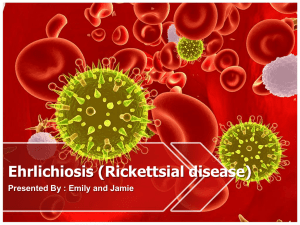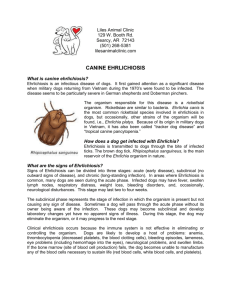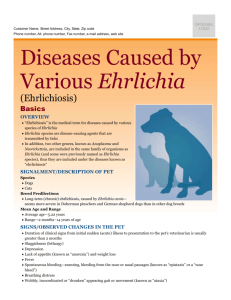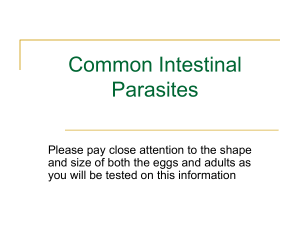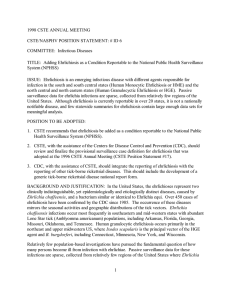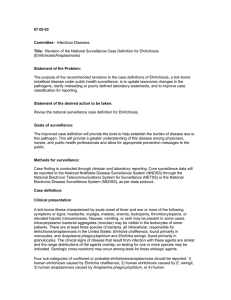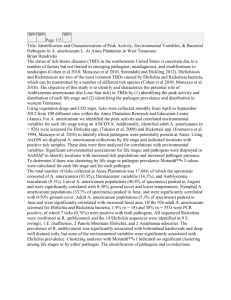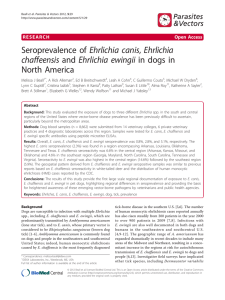White cell parasites of dogs and cats
advertisement
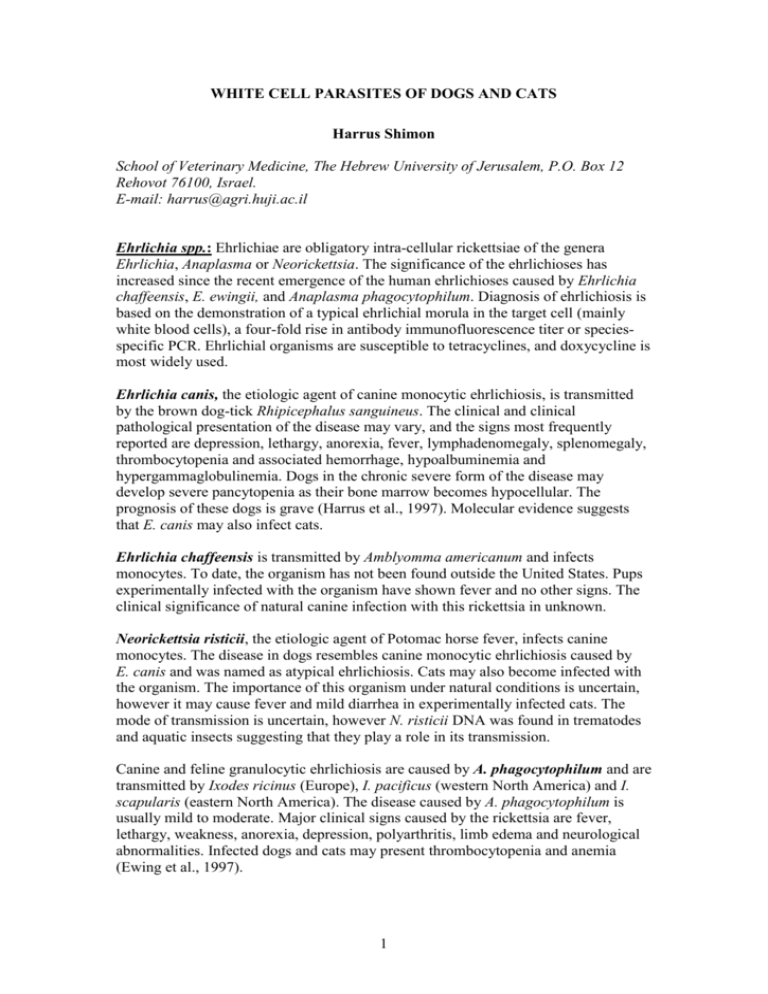
WHITE CELL PARASITES OF DOGS AND CATS Harrus Shimon School of Veterinary Medicine, The Hebrew University of Jerusalem, P.O. Box 12 Rehovot 76100, Israel. E-mail: harrus@agri.huji.ac.il Ehrlichia spp.: Ehrlichiae are obligatory intra-cellular rickettsiae of the genera Ehrlichia, Anaplasma or Neorickettsia. The significance of the ehrlichioses has increased since the recent emergence of the human ehrlichioses caused by Ehrlichia chaffeensis, E. ewingii, and Anaplasma phagocytophilum. Diagnosis of ehrlichiosis is based on the demonstration of a typical ehrlichial morula in the target cell (mainly white blood cells), a four-fold rise in antibody immunofluorescence titer or speciesspecific PCR. Ehrlichial organisms are susceptible to tetracyclines, and doxycycline is most widely used. Ehrlichia canis, the etiologic agent of canine monocytic ehrlichiosis, is transmitted by the brown dog-tick Rhipicephalus sanguineus. The clinical and clinical pathological presentation of the disease may vary, and the signs most frequently reported are depression, lethargy, anorexia, fever, lymphadenomegaly, splenomegaly, thrombocytopenia and associated hemorrhage, hypoalbuminemia and hypergammaglobulinemia. Dogs in the chronic severe form of the disease may develop severe pancytopenia as their bone marrow becomes hypocellular. The prognosis of these dogs is grave (Harrus et al., 1997). Molecular evidence suggests that E. canis may also infect cats. Ehrlichia chaffeensis is transmitted by Amblyomma americanum and infects monocytes. To date, the organism has not been found outside the United States. Pups experimentally infected with the organism have shown fever and no other signs. The clinical significance of natural canine infection with this rickettsia in unknown. Neorickettsia risticii, the etiologic agent of Potomac horse fever, infects canine monocytes. The disease in dogs resembles canine monocytic ehrlichiosis caused by E. canis and was named as atypical ehrlichiosis. Cats may also become infected with the organism. The importance of this organism under natural conditions is uncertain, however it may cause fever and mild diarrhea in experimentally infected cats. The mode of transmission is uncertain, however N. risticii DNA was found in trematodes and aquatic insects suggesting that they play a role in its transmission. Canine and feline granulocytic ehrlichiosis are caused by A. phagocytophilum and are transmitted by Ixodes ricinus (Europe), I. pacificus (western North America) and I. scapularis (eastern North America). The disease caused by A. phagocytophilum is usually mild to moderate. Major clinical signs caused by the rickettsia are fever, lethargy, weakness, anorexia, depression, polyarthritis, limb edema and neurological abnormalities. Infected dogs and cats may present thrombocytopenia and anemia (Ewing et al., 1997). 1 Ehrlichia ewingii has recently been reported to infect humans. It is transmitted by A. americanum and infects granulocytes. Natural and experimental infection of dogs with E. ewingii may cause polyarthritis characterized by lameness, joint swelling, stiff gait, and thrombocytopenia (Buller et al, 1999). Leishmania spp.: Canine leishmaniasis is caused by the protozoon Leishmania infantum in the Mediteranean basin and L. chagasi (synonym of L. infantum) in South America. The vectors of L. infantum and L. chagasi are sand flies (Phlebotomus & Lutzomyia spp.,). Leishmanial amastigotes may be seen in macrophages aspirated from lymph nodes, spleens, bone marrow and skin of infected animals. The organism induces immune complexes formation, and those are being deposited in the kidneys, and blood vessels resulting in glomerulonephritis and vasculitis, respectively. Common clinical signs in affected dogs include lymphadenomegaly, splenomegaly, exfoliative dermatitis, skin ulcerations, weight loss, uveitis, conjunctivitis and onychogryphosis. Common hematological abnormalities include anemia and thrombocytopenia. Palliation may be achieved by the use of meglumine antimoniate or allopurinol, however treatment cessation may result in the recurrence of clinical signs. Hepatozoon spp.: Hepatozoonoses are caused by the apicomplexan hemoparasites Hepatozoon canis and Hepatozoon americanum. These closely related organisms cause two distinct clinical syndromes. H. canis is transmitted by R. sanguineus (by ingestion of the tick) and infects neutrophils. The disease caused by the parasite is usually subclinical or mild, however may be moderate to severe and even fatal, depending on the immune status of the animal. Common clinical signs include fever, lethargy and emaciation. While the presence of H. canis-gamonts is common in neutrophils of infected animals, it is rarely found in animals infected with H. americanum. The latter is transmitted by Amblyomma maculatum (by ingestion) and causes a severe disease, characterized by pyogranulomatous myositis and bone involvement. Most common findings include gait abnormalities, muscular hyperesthesia, fever, lethargy, periosteal proliferation of the long bones and pronounced leukocytosis. Immunosupressed cats (e.g. cats infected with FIV) may also become infected with Hepatozoon sp. organism. Its species has yet to be determined (Baneth et al., 2003). References Baneth G, Mathew J.S., Shkap V., Macintire D.K., Barta J.R., Ewing S.A., 2003. Canine hepatozoonosis: two disease syndromes caused by separate Hepatozoon spp. Trends Parasitol., 19: 27-31. Buller R.S., Arens M., Hmiel S.P., Paddock C.D., Sumner J.W., Rikhisa Y., Unver A., Gaudreault-Keener M., Manian F.A., Liddell A.M., Schmulewitz N., Storch G.A., 1999. Ehrlichia ewingii, a newly recognized agent of human ehrlichiosis. N. Eng. J. Med., 341: 148-155. Ewing S.A., Dawson J.E., Panciera R.J., Mathew J.S., Pratt K.W., Katavolos P., Telford S.R., 1997. Dogs infected with human granulocytotropic Ehrlichia spp. (Rickettsiales: Ehrlichieae). J. Med. Entomol., 34: 710-718. Harrus S., Waner T., Bark H., 1997. Canine monocytic ehrlichiosis - an update. Comp. Cont. Educ. Pract., 19: 431-444. 2
